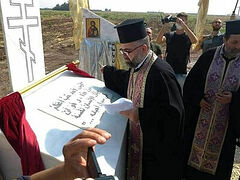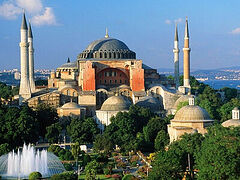In 2020, the Turkish authorities turned Hagia Sophia of Constantinople (now Istanbul) into a mosque, concealing its world-famous Byzantine mosaics. At the same time Archpriest Theodore (Fyodor) Gignadze, rector of the Church of the Exaltation of the Holy Cross in Tbilisi, commissioned a replica of the most famous Byzantine mosaic—the image of Christ the Pantokrator—and had it installed in the apse of his church. Below is an account of this event.
A copy of the Pantokrator from Constantinople’s Hagia Sophia was solemnly unveiled at the Church of the Exaltation of the Cross in Tbilisi on the Sunday of the Triumph of Orthodoxy in 2021—a feast established in honor of the victory over the heresy of iconoclasm.
“Since the Lord came in the form of a Man, since I saw Him, it is natural for me to have the desire to contemplate Him constantly in church,” Fr. Theodore points out to the fact that veneration of icons for Christian believers is natural.
By the decision of Fr. Theodore, all the features were taken into account when creating the copy: the elements of the mosaic that were lost over time are absent in this replica as well. Fr. Theodore connects the absence of a part of the image with our sins:
“As many gems are missing in this image as are missing on the original. And we lack them because of our sins.
“A huge Byzantine Empire was once created. We don’t know where the spark that created this astounding thousand-year-long Christian culture came from. But the time came when that most splendid, majestic church [the Hagia Sophia, the Wisdom of God.—Auth.], which resembles heaven even by its appearance, ceased to be ours, or Christian, because of our sins.
“It so happened that even what we had had was taken away from us. We know that the most beautiful mosaics of that church were concealed, and, consequently, today we no longer have the opportunity to contemplate them. But at the same time, Divine grace, the image of God Incarnate is that water, which, if you block one of its outlets, will surely find another. Here, at the top [above the altar of the church in Tbilisi.—Auth.], is what was concealed there and will be revealed here.”1
The craftsman Amiran Bakuradze, who took on this laborious task, has agreed to comment on the specifics of creating the copy of the image of the Pantokrator for the Church of the Exaltation of the Cross:
“First of all, it was difficult to find a replica of this mosaic. It was decided to compare several images and take the most successful fragment from each. So the complete image was assembled piece by piece. This was the most difficult part of the job.
“The selection of shades had its specifics as well. The fact is that over time, stone fades, as does the gilding that is present in this image. And we tried to get precisely the shade this mosaic has today, taking fading into account.
“In view of this, it was not enough for us just to choose a stone of the desired shade or put on gilding, which would have given us the original version of this image, created centuries ago. To achieve the desired effect we needed to bring the color of the mosaic elements to such a condition that displays the imprint of past centuries. And this took a lot of time.
“Stone for this work was ordered from Italy, since the required palette of shades was not available to us here. Of course, delivery during the pandemic was somewhat complicated, but we had no alternative.
“Of course, we were aware of the responsibility and complexity of the work: the creation of a replica of such a work of art, especially when all the features should be taken into account, required a thorough study and a serious approach.
“A total of ten craftsmen took part in the work. For convenience we were divided into several subgroups. Some of us were responsible for studying the original in full, right down to where each stone was missing and how it was better to display it. The mosaic composition was divided into fragments, and after their completion they were united into one single image.”
May God grant that this ancient image of Christ, transferred from historical Constantinople to modern Tbilisi, would help strengthen the faith of the Georgian people, increase Divine help from above, and become a solid foundation for truly fraternal relations between all Christian peoples.




